Individual Project Report: Maintenance, Breakdown, and Inventory
VerifiedAdded on 2023/01/11
|7
|1053
|34
Project
AI Summary
This project report delves into the critical aspects of maintenance within a business context, focusing on breakdown analysis and inventory management. The report begins with an introduction emphasizing the importance of addressing machine failures and their impact on operations. The main body is divided into sections, the first of which presents a detailed breakdown analysis, including calculations of expected breakdowns, associated costs, and the cost-effectiveness of preventive maintenance contracts. The second section explores tools for defining priorities in scheduled maintenance, with a specific focus on inventory management methods. It evaluates the suitability of the FIFO method, highlighting its drawbacks, and suggests alternatives like LIFO. The report concludes by summarizing the key findings and reiterating the importance of considering breakdown analysis and inventory management when making maintenance-related decisions. References to relevant academic sources are also included.
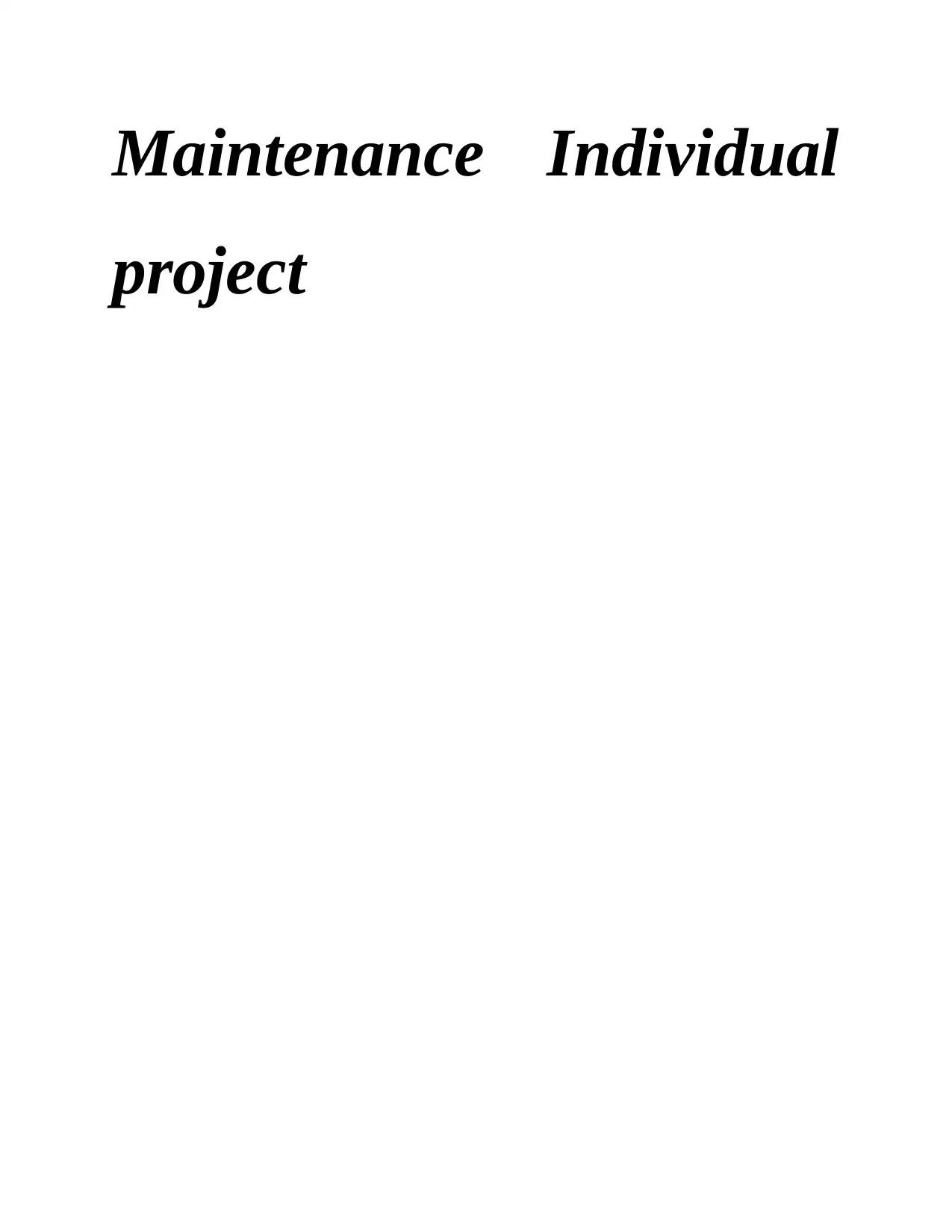
Maintenance Individual
project
project
Paraphrase This Document
Need a fresh take? Get an instant paraphrase of this document with our AI Paraphraser
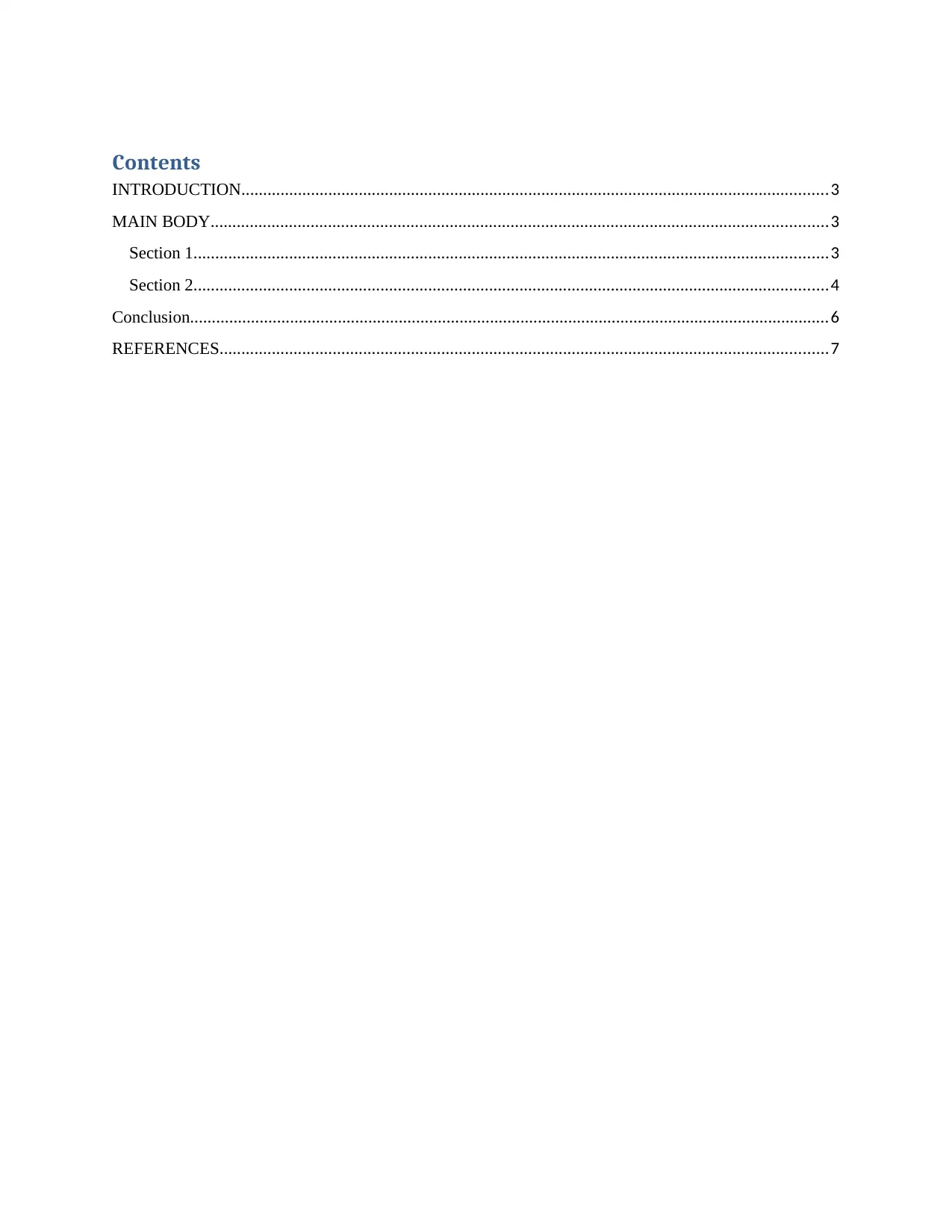
Contents
INTRODUCTION.......................................................................................................................................3
MAIN BODY..............................................................................................................................................3
Section 1..................................................................................................................................................3
Section 2..................................................................................................................................................4
Conclusion...................................................................................................................................................6
REFERENCES............................................................................................................................................7
INTRODUCTION.......................................................................................................................................3
MAIN BODY..............................................................................................................................................3
Section 1..................................................................................................................................................3
Section 2..................................................................................................................................................4
Conclusion...................................................................................................................................................6
REFERENCES............................................................................................................................................7
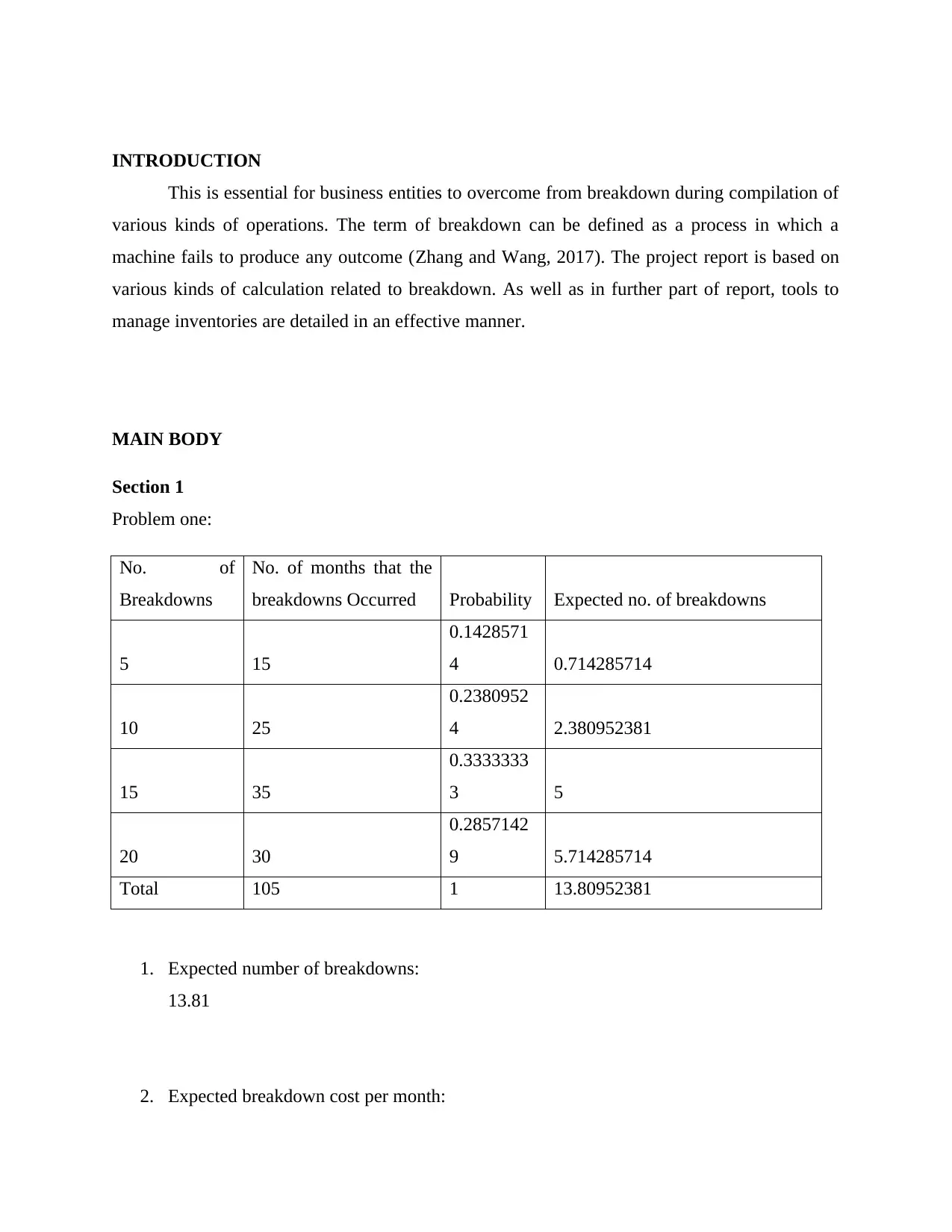
INTRODUCTION
This is essential for business entities to overcome from breakdown during compilation of
various kinds of operations. The term of breakdown can be defined as a process in which a
machine fails to produce any outcome (Zhang and Wang, 2017). The project report is based on
various kinds of calculation related to breakdown. As well as in further part of report, tools to
manage inventories are detailed in an effective manner.
MAIN BODY
Section 1
Problem one:
No. of
Breakdowns
No. of months that the
breakdowns Occurred Probability Expected no. of breakdowns
5 15
0.1428571
4 0.714285714
10 25
0.2380952
4 2.380952381
15 35
0.3333333
3 5
20 30
0.2857142
9 5.714285714
Total 105 1 13.80952381
1. Expected number of breakdowns:
13.81
2. Expected breakdown cost per month:
This is essential for business entities to overcome from breakdown during compilation of
various kinds of operations. The term of breakdown can be defined as a process in which a
machine fails to produce any outcome (Zhang and Wang, 2017). The project report is based on
various kinds of calculation related to breakdown. As well as in further part of report, tools to
manage inventories are detailed in an effective manner.
MAIN BODY
Section 1
Problem one:
No. of
Breakdowns
No. of months that the
breakdowns Occurred Probability Expected no. of breakdowns
5 15
0.1428571
4 0.714285714
10 25
0.2380952
4 2.380952381
15 35
0.3333333
3 5
20 30
0.2857142
9 5.714285714
Total 105 1 13.80952381
1. Expected number of breakdowns:
13.81
2. Expected breakdown cost per month:
⊘ This is a preview!⊘
Do you want full access?
Subscribe today to unlock all pages.

Trusted by 1+ million students worldwide
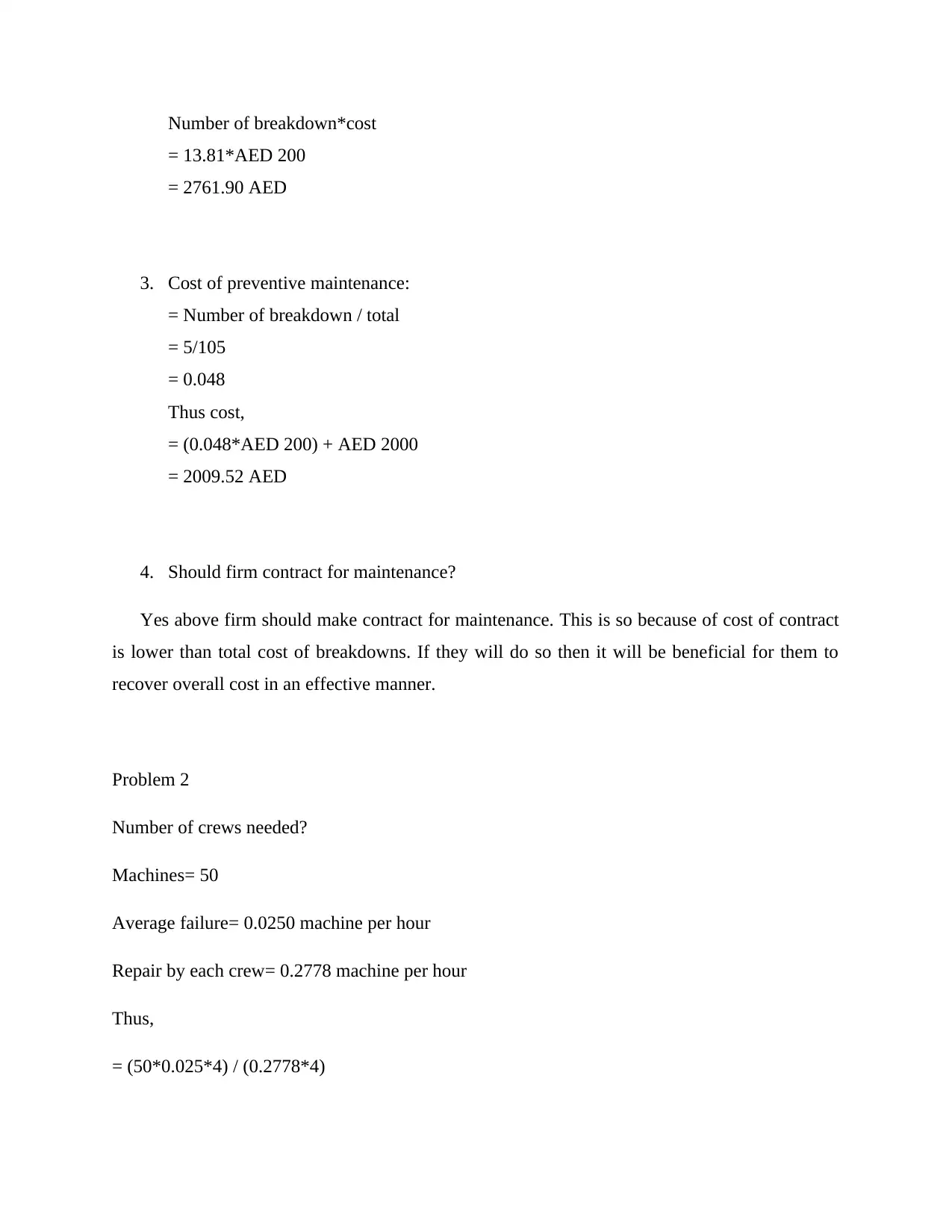
Number of breakdown*cost
= 13.81*AED 200
= 2761.90 AED
3. Cost of preventive maintenance:
= Number of breakdown / total
= 5/105
= 0.048
Thus cost,
= (0.048*AED 200) + AED 2000
= 2009.52 AED
4. Should firm contract for maintenance?
Yes above firm should make contract for maintenance. This is so because of cost of contract
is lower than total cost of breakdowns. If they will do so then it will be beneficial for them to
recover overall cost in an effective manner.
Problem 2
Number of crews needed?
Machines= 50
Average failure= 0.0250 machine per hour
Repair by each crew= 0.2778 machine per hour
Thus,
= (50*0.025*4) / (0.2778*4)
= 13.81*AED 200
= 2761.90 AED
3. Cost of preventive maintenance:
= Number of breakdown / total
= 5/105
= 0.048
Thus cost,
= (0.048*AED 200) + AED 2000
= 2009.52 AED
4. Should firm contract for maintenance?
Yes above firm should make contract for maintenance. This is so because of cost of contract
is lower than total cost of breakdowns. If they will do so then it will be beneficial for them to
recover overall cost in an effective manner.
Problem 2
Number of crews needed?
Machines= 50
Average failure= 0.0250 machine per hour
Repair by each crew= 0.2778 machine per hour
Thus,
= (50*0.025*4) / (0.2778*4)
Paraphrase This Document
Need a fresh take? Get an instant paraphrase of this document with our AI Paraphraser
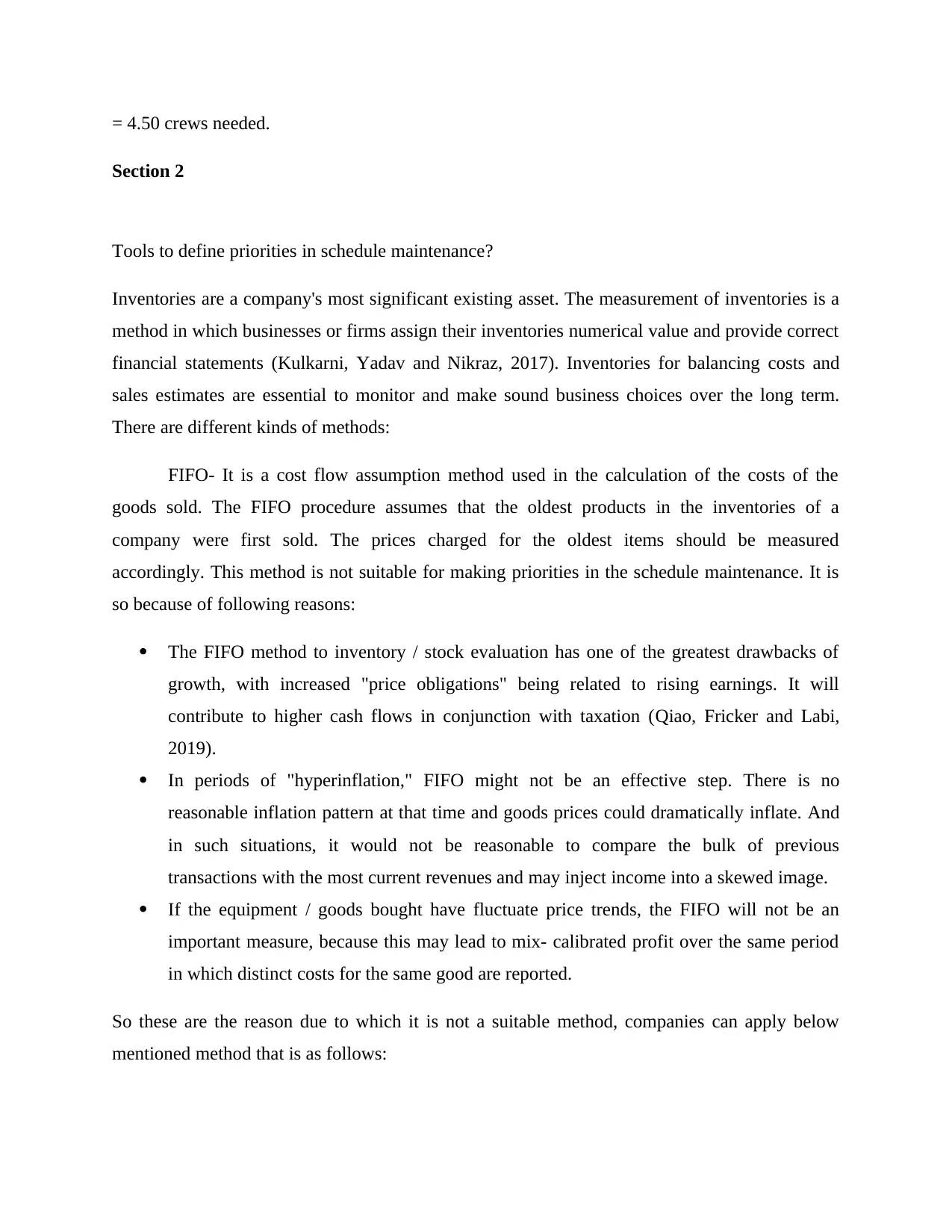
= 4.50 crews needed.
Section 2
Tools to define priorities in schedule maintenance?
Inventories are a company's most significant existing asset. The measurement of inventories is a
method in which businesses or firms assign their inventories numerical value and provide correct
financial statements (Kulkarni, Yadav and Nikraz, 2017). Inventories for balancing costs and
sales estimates are essential to monitor and make sound business choices over the long term.
There are different kinds of methods:
FIFO- It is a cost flow assumption method used in the calculation of the costs of the
goods sold. The FIFO procedure assumes that the oldest products in the inventories of a
company were first sold. The prices charged for the oldest items should be measured
accordingly. This method is not suitable for making priorities in the schedule maintenance. It is
so because of following reasons:
The FIFO method to inventory / stock evaluation has one of the greatest drawbacks of
growth, with increased "price obligations" being related to rising earnings. It will
contribute to higher cash flows in conjunction with taxation (Qiao, Fricker and Labi,
2019).
In periods of "hyperinflation," FIFO might not be an effective step. There is no
reasonable inflation pattern at that time and goods prices could dramatically inflate. And
in such situations, it would not be reasonable to compare the bulk of previous
transactions with the most current revenues and may inject income into a skewed image.
If the equipment / goods bought have fluctuate price trends, the FIFO will not be an
important measure, because this may lead to mix- calibrated profit over the same period
in which distinct costs for the same good are reported.
So these are the reason due to which it is not a suitable method, companies can apply below
mentioned method that is as follows:
Section 2
Tools to define priorities in schedule maintenance?
Inventories are a company's most significant existing asset. The measurement of inventories is a
method in which businesses or firms assign their inventories numerical value and provide correct
financial statements (Kulkarni, Yadav and Nikraz, 2017). Inventories for balancing costs and
sales estimates are essential to monitor and make sound business choices over the long term.
There are different kinds of methods:
FIFO- It is a cost flow assumption method used in the calculation of the costs of the
goods sold. The FIFO procedure assumes that the oldest products in the inventories of a
company were first sold. The prices charged for the oldest items should be measured
accordingly. This method is not suitable for making priorities in the schedule maintenance. It is
so because of following reasons:
The FIFO method to inventory / stock evaluation has one of the greatest drawbacks of
growth, with increased "price obligations" being related to rising earnings. It will
contribute to higher cash flows in conjunction with taxation (Qiao, Fricker and Labi,
2019).
In periods of "hyperinflation," FIFO might not be an effective step. There is no
reasonable inflation pattern at that time and goods prices could dramatically inflate. And
in such situations, it would not be reasonable to compare the bulk of previous
transactions with the most current revenues and may inject income into a skewed image.
If the equipment / goods bought have fluctuate price trends, the FIFO will not be an
important measure, because this may lead to mix- calibrated profit over the same period
in which distinct costs for the same good are reported.
So these are the reason due to which it is not a suitable method, companies can apply below
mentioned method that is as follows:
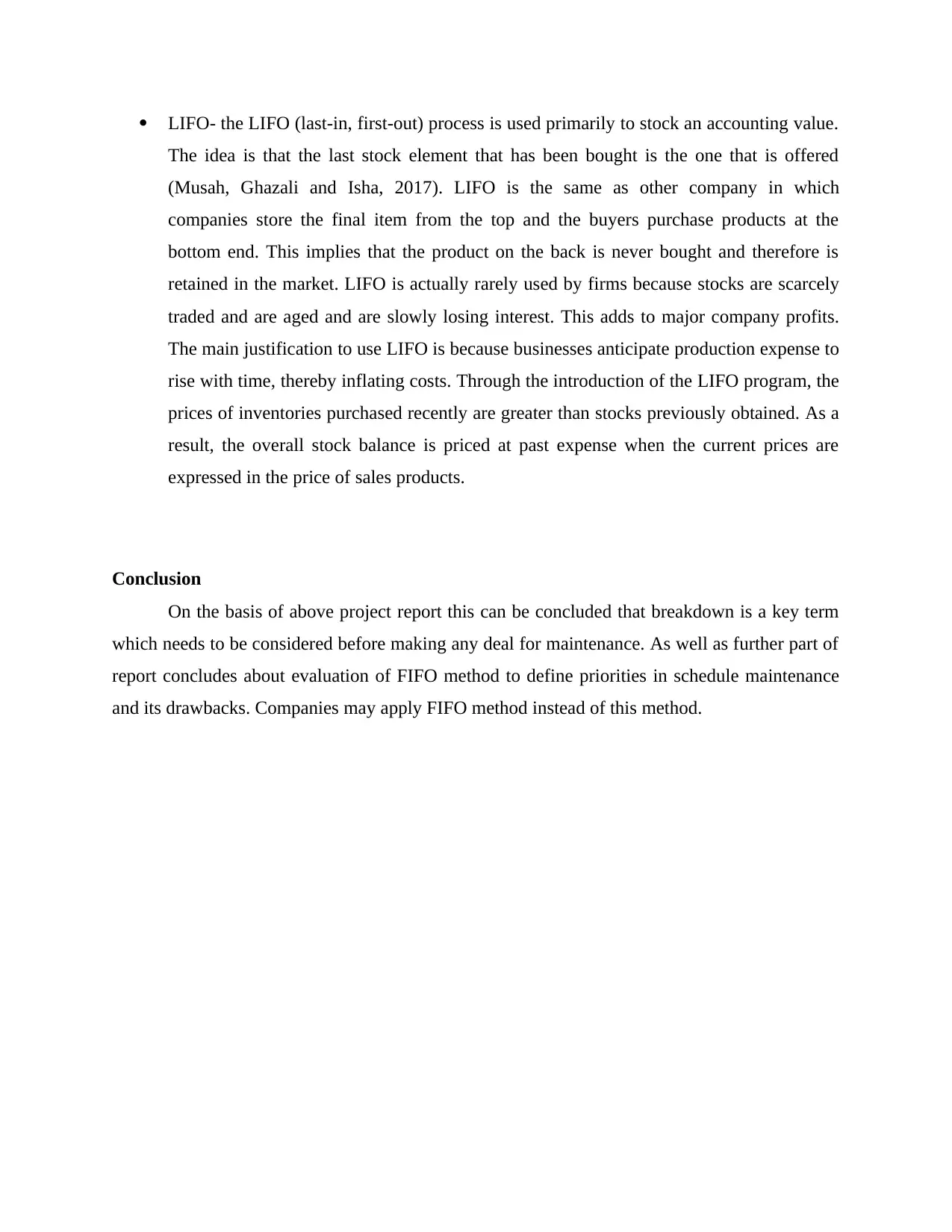
LIFO- the LIFO (last-in, first-out) process is used primarily to stock an accounting value.
The idea is that the last stock element that has been bought is the one that is offered
(Musah, Ghazali and Isha, 2017). LIFO is the same as other company in which
companies store the final item from the top and the buyers purchase products at the
bottom end. This implies that the product on the back is never bought and therefore is
retained in the market. LIFO is actually rarely used by firms because stocks are scarcely
traded and are aged and are slowly losing interest. This adds to major company profits.
The main justification to use LIFO is because businesses anticipate production expense to
rise with time, thereby inflating costs. Through the introduction of the LIFO program, the
prices of inventories purchased recently are greater than stocks previously obtained. As a
result, the overall stock balance is priced at past expense when the current prices are
expressed in the price of sales products.
Conclusion
On the basis of above project report this can be concluded that breakdown is a key term
which needs to be considered before making any deal for maintenance. As well as further part of
report concludes about evaluation of FIFO method to define priorities in schedule maintenance
and its drawbacks. Companies may apply FIFO method instead of this method.
The idea is that the last stock element that has been bought is the one that is offered
(Musah, Ghazali and Isha, 2017). LIFO is the same as other company in which
companies store the final item from the top and the buyers purchase products at the
bottom end. This implies that the product on the back is never bought and therefore is
retained in the market. LIFO is actually rarely used by firms because stocks are scarcely
traded and are aged and are slowly losing interest. This adds to major company profits.
The main justification to use LIFO is because businesses anticipate production expense to
rise with time, thereby inflating costs. Through the introduction of the LIFO program, the
prices of inventories purchased recently are greater than stocks previously obtained. As a
result, the overall stock balance is priced at past expense when the current prices are
expressed in the price of sales products.
Conclusion
On the basis of above project report this can be concluded that breakdown is a key term
which needs to be considered before making any deal for maintenance. As well as further part of
report concludes about evaluation of FIFO method to define priorities in schedule maintenance
and its drawbacks. Companies may apply FIFO method instead of this method.
⊘ This is a preview!⊘
Do you want full access?
Subscribe today to unlock all pages.

Trusted by 1+ million students worldwide
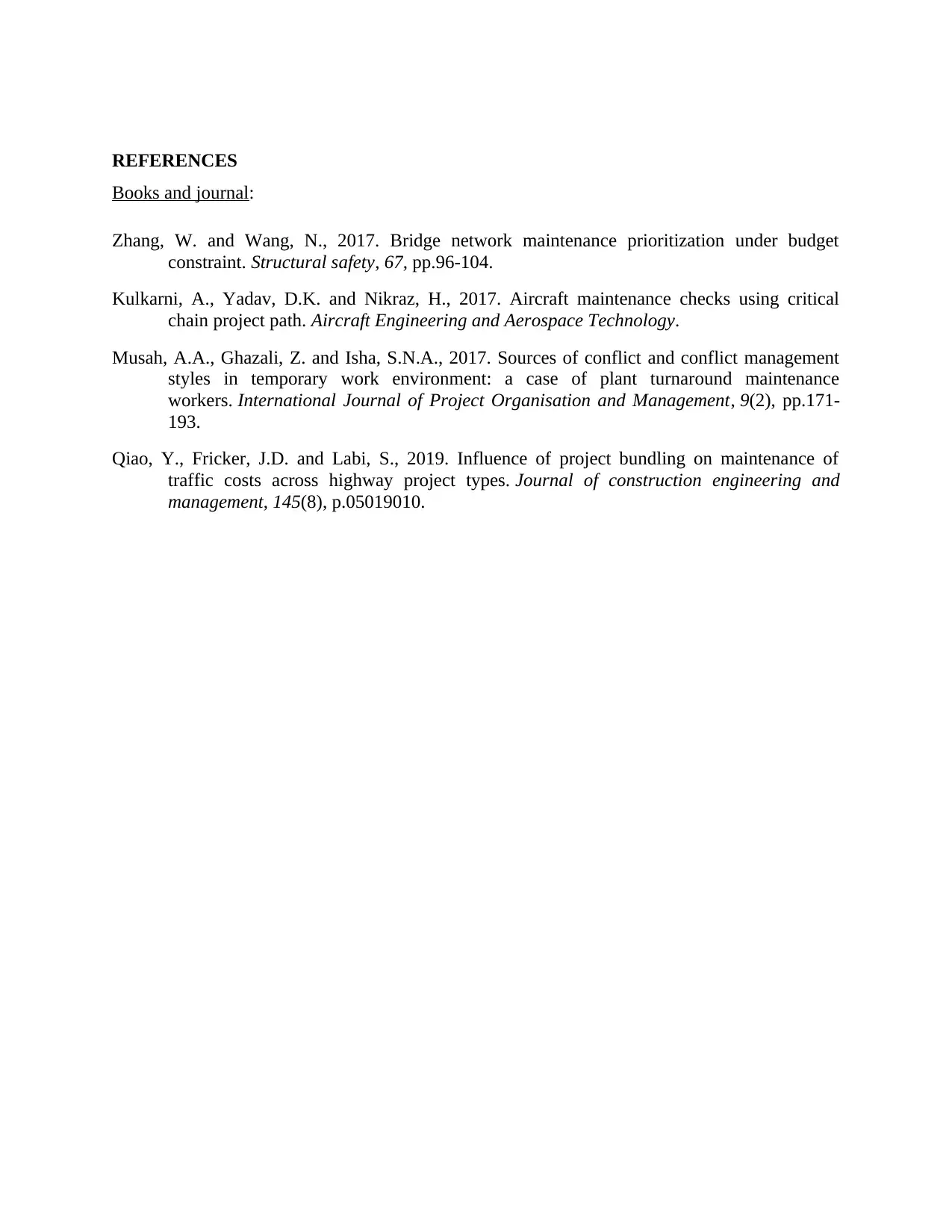
REFERENCES
Books and journal:
Zhang, W. and Wang, N., 2017. Bridge network maintenance prioritization under budget
constraint. Structural safety, 67, pp.96-104.
Kulkarni, A., Yadav, D.K. and Nikraz, H., 2017. Aircraft maintenance checks using critical
chain project path. Aircraft Engineering and Aerospace Technology.
Musah, A.A., Ghazali, Z. and Isha, S.N.A., 2017. Sources of conflict and conflict management
styles in temporary work environment: a case of plant turnaround maintenance
workers. International Journal of Project Organisation and Management, 9(2), pp.171-
193.
Qiao, Y., Fricker, J.D. and Labi, S., 2019. Influence of project bundling on maintenance of
traffic costs across highway project types. Journal of construction engineering and
management, 145(8), p.05019010.
Books and journal:
Zhang, W. and Wang, N., 2017. Bridge network maintenance prioritization under budget
constraint. Structural safety, 67, pp.96-104.
Kulkarni, A., Yadav, D.K. and Nikraz, H., 2017. Aircraft maintenance checks using critical
chain project path. Aircraft Engineering and Aerospace Technology.
Musah, A.A., Ghazali, Z. and Isha, S.N.A., 2017. Sources of conflict and conflict management
styles in temporary work environment: a case of plant turnaround maintenance
workers. International Journal of Project Organisation and Management, 9(2), pp.171-
193.
Qiao, Y., Fricker, J.D. and Labi, S., 2019. Influence of project bundling on maintenance of
traffic costs across highway project types. Journal of construction engineering and
management, 145(8), p.05019010.
1 out of 7
Your All-in-One AI-Powered Toolkit for Academic Success.
+13062052269
info@desklib.com
Available 24*7 on WhatsApp / Email
![[object Object]](/_next/static/media/star-bottom.7253800d.svg)
Unlock your academic potential
Copyright © 2020–2025 A2Z Services. All Rights Reserved. Developed and managed by ZUCOL.